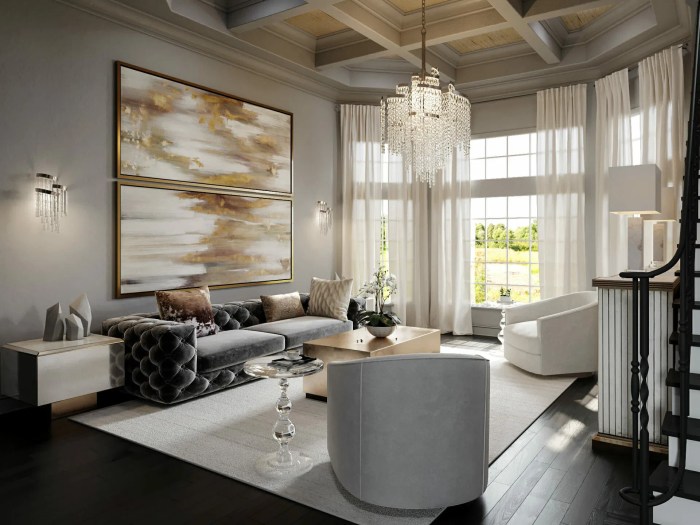How to achieve a luxurious interior design on a budget? It sounds like a contradiction, but it’s entirely possible! This guide unveils the secrets to transforming your living space into a haven of elegance without breaking the bank. We’ll explore clever shopping strategies, DIY techniques, and design tricks that will leave your home feeling opulent and sophisticated, proving that luxury isn’t always synonymous with exorbitant spending.
We’ll delve into the core elements of luxurious design – from carefully chosen materials and textures to strategic lighting and space planning – and show you how to replicate high-end looks using affordable alternatives. Learn how to source secondhand treasures, negotiate prices, and upcycle existing items to create unique, personalized pieces that reflect your style. Get ready to unlock your inner interior designer and create a space that truly reflects your vision of luxury, all without overspending.
Defining “Luxurious” on a Budget
Achieving a luxurious interior design doesn’t necessitate a king’s ransom. It’s about creating a space that feels opulent, sophisticated, and inviting, even on a tighter budget. This involves a strategic approach to material selection, lighting, and spatial planning, focusing on quality over quantity and impactful details over overwhelming extravagance.
Luxurious interior design is fundamentally about creating a sense of calm, sophistication, and high-quality craftsmanship. This is achieved through a careful selection of materials with a focus on texture and visual appeal. Lighting plays a crucial role in setting the mood and highlighting key features. Finally, clever space planning maximizes the available area, creating a sense of flow and spaciousness.
While high-end materials like solid marble and cashmere are undeniably luxurious, achieving a similar aesthetic on a budget is entirely possible.
Budget-Friendly Materials Mimicking High-End Looks
The key to budget-friendly luxury lies in choosing materials that offer the look and feel of high-end options without the hefty price tag. Faux finishes are your best friend. Faux marble countertops and backsplashes, for instance, can convincingly mimic the look of real marble at a fraction of the cost. Similarly, linen-blend fabrics provide a luxurious drape and texture similar to pure linen, but at a more accessible price point.
Consider using high-quality vinyl flooring that imitates the look of hardwood or stone. These alternatives offer durability and elegance without breaking the bank. Another excellent option is using well-chosen wallpapers to create a dramatic focal point in a room, adding visual interest and depth without needing extensive redecorating.
Creating a Sense of Spaciousness and Flow in Small Spaces
Even a small space can feel luxurious if designed thoughtfully. The trick lies in maximizing natural light and creating a sense of flow. Light, neutral colors on walls and floors make a room feel larger. Mirrors strategically placed can reflect light and create the illusion of more space. Decluttering is crucial; less is definitely more when aiming for a luxurious feel.
Multi-functional furniture, such as ottomans with storage or sofa beds, helps to optimize space. Keeping the color palette consistent and minimizing visual clutter contributes to a feeling of spaciousness and calm. Consider using sheer curtains or blinds to allow ample natural light while maintaining privacy.
Mood Board: Luxurious Yet Affordable Design Choices
Imagine a living room with walls painted in a soft, warm gray. The focal point is a large, inexpensive mirror in an ornate frame, reflecting the light from a strategically placed floor lamp with a sleek, modern design. The seating area features a comfortable, linen-blend sofa in a neutral beige tone, paired with two smaller armchairs in a coordinating fabric.
A faux marble coffee table anchors the space, its sleek surface reflecting the light. A few carefully chosen throw pillows in rich textures, such as velvet or faux fur, add pops of color and visual interest. A simple, yet elegant rug in a neutral tone defines the seating area and adds warmth underfoot. The overall effect is one of sophisticated simplicity, creating a luxurious feel without extravagance.
This approach focuses on quality pieces that are well-chosen and arranged, emphasizing texture, light, and a cohesive color palette.
Strategic Shopping and Sourcing
Creating a luxurious look on a budget requires a smart approach to shopping. This involves carefully considering where you source your furniture and décor, understanding the trade-offs between different options, and employing savvy negotiation tactics. By strategically selecting pieces and prioritizing quality over quantity, you can achieve a high-end aesthetic without breaking the bank.
Secondhand Furniture and Décor: Advantages and Disadvantages
Buying pre-owned furniture and décor offers significant advantages for budget-conscious design enthusiasts. The most obvious benefit is the cost savings; you can often find high-quality pieces at a fraction of their original price. This allows you to invest in more substantial items or splurge on a few key statement pieces. Furthermore, secondhand shopping contributes to sustainability by reducing waste and giving items a second life.
However, there are potential drawbacks. Secondhand items may require repairs or restoration, adding to the overall cost and effort. Finding pieces that match your style and are in good condition can also take time and patience. Thorough inspection is crucial to avoid purchasing items with hidden damage or structural issues.
Price and Quality Comparison: Big Box Stores vs. Independent Shops
Big box stores typically offer lower prices on mass-produced furniture and décor, making them attractive for budget-conscious shoppers. However, the quality of materials and craftsmanship is often lower, and the designs tend to be less unique. Independent shops, on the other hand, often carry higher-quality, handcrafted items with more distinctive designs. While prices are generally higher, these pieces can be more durable and possess a greater sense of individuality, contributing to a more luxurious feel.
For example, a solid wood dining table from an independent furniture maker will likely last much longer and look more refined than a similar-looking piece from a large chain store made from particleboard. The trade-off lies in balancing affordability with longevity and style.
Negotiating Prices and Finding Discounts
Negotiating prices, particularly at independent shops and antique stores, is often possible and can yield significant savings. Researching comparable prices online beforehand gives you leverage during negotiations. Don’t be afraid to politely inquire about discounts, especially if purchasing multiple items or if the piece shows minor imperfections. Shopping during sales periods, such as end-of-season clearances or holiday sales, can also lead to significant discounts.
Many retailers offer loyalty programs or email sign-ups that provide access to exclusive discounts and promotions. Being flexible with your timeframe and willing to compromise on less crucial items can also increase your negotiating power.
Sample Shopping List: Prioritizing Essential Pieces
Before you start shopping, create a prioritized list focusing on essential pieces that will have the biggest impact on the overall look and feel of your space. Avoid impulse buys. A sample list might include:
- A high-quality sofa or sectional in a neutral color that can serve as a foundation for the room.
- A statement rug to define the space and add texture.
- Curtains or blinds to control light and add privacy.
- A well-made coffee table or side tables.
- Adequate lighting: a combination of ambient, task, and accent lighting.
Once these key pieces are in place, you can gradually add smaller accessories and décor items to personalize the space and enhance the luxurious feel without exceeding your budget. Remember that a few well-chosen, high-quality pieces will always create a more luxurious impression than many cheap, poorly made items.
DIY and Upcycling Techniques

Source: decorilla.com
Transforming your home into a luxurious haven doesn’t require a hefty budget; clever DIY and upcycling techniques can achieve stunning results. By repurposing existing items and adding personalized touches, you can create a unique and opulent atmosphere without breaking the bank. This section will guide you through simple yet effective methods to elevate your interior design.
Painting Furniture for a Luxurious Look
A fresh coat of paint can dramatically change the look of an old piece of furniture. Choosing the right color and finish is key to achieving a luxurious feel. For example, a dark, rich color like emerald green or deep navy blue on a simple wooden dresser can instantly elevate its appearance. A high-gloss finish adds a touch of glamour, while a matte finish provides a more sophisticated, understated elegance.Here’s a step-by-step guide to painting a piece of furniture:
1. Preparation
Clean the furniture thoroughly with a degreaser to remove any dirt, grease, or old wax. Sand the surface lightly to create a smooth base for the paint. Fill any holes or cracks with wood filler and sand smooth once dry.
2. Priming
Apply a coat of primer specifically designed for furniture. This will help the paint adhere better and prevent bleed-through from the original wood or finish. Allow the primer to dry completely according to the manufacturer’s instructions.
3. Painting
Apply several thin coats of paint, allowing each coat to dry before applying the next. Using a high-quality brush or roller will result in a smoother, more professional finish. For a truly luxurious look, consider using a paint sprayer for an even, flawless coat.
4. Finishing
Once the paint is dry, apply a clear coat of sealant to protect the finish and add a layer of sheen. This will help to prevent scratches and make the furniture easier to clean.
Upcycling Existing Furniture and Décor
Upcycling involves transforming old or unwanted items into something new and valuable. For example, an old wooden chair can be reupholstered with luxurious velvet fabric to create a statement piece. Adding decorative trim or tassels further enhances the luxurious feel. Similarly, plain lampshades can be upgraded with fabric remnants, creating unique and stylish lighting features. Consider adding metallic accents – gold leaf, brass knobs, or copper piping – to existing pieces to instantly elevate their aesthetic.
Refinishing Furniture to Improve Appearance and Value
Refinishing furniture involves stripping away old finishes and applying new ones, often requiring more time and effort than painting. This process can significantly increase the value and luxury of a piece. For example, refinishing an antique wooden table to reveal its natural grain and applying a protective varnish can dramatically transform its look. This process involves careful sanding, cleaning, and applying multiple coats of stain and varnish to achieve the desired finish.
Always research the specific type of wood you are working with and use appropriate finishing products.
Tools and Materials for Common DIY Projects
The following table lists essential tools and materials for common DIY projects, along with cost estimates and sourcing information. These are estimates and prices may vary depending on location and retailer.
| Tool | Description | Cost Estimate | Source |
|---|---|---|---|
| Sandpaper (various grits) | Used for smoothing surfaces before painting or refinishing. | $10 – $20 | Hardware store, home improvement center |
| Paintbrushes/Roller | For applying paint evenly and smoothly. | $5 – $25 | Hardware store, art supply store |
| Primer | Prepares surfaces for painting, improves adhesion. | $15 – $30 | Hardware store, home improvement center |
| Paint | High-quality paint is essential for a luxurious finish. | $20 – $50+ | Hardware store, paint store |
| Wood Filler | For repairing holes and cracks in wood furniture. | $5 – $15 | Hardware store, home improvement center |
| Clear Coat Sealer | Protects the paint and adds sheen. | $10 – $25 | Hardware store, home improvement center |
| Fabric (for upholstery) | High-quality fabric enhances the luxury of upholstered furniture. | $20 – $50+ per yard | Fabric store, online retailer |
| Staple Gun | For attaching fabric to furniture frames. | $20 – $40 | Hardware store, home improvement center |
Color Palette and Lighting Strategies
Creating a luxurious feel on a budget relies heavily on clever use of color and light. These elements, often overlooked, can dramatically elevate the perceived value of your space, making it feel richer and more sophisticated than the price tag suggests. Strategic choices in both areas are key to achieving a high-end aesthetic without breaking the bank.Color psychology plays a significant role in shaping the mood and perception of a room.
Certain colors inherently evoke feelings of luxury, opulence, and sophistication. Mastering this aspect can transform your home’s atmosphere, contributing to an overall sense of refined elegance.
Color Palette for Luxurious Ambiance
A successful luxury color palette doesn’t require expensive paints. Instead, focus on creating a cohesive and balanced scheme using a few key colors. Think deep, rich jewel tones such as emerald green, sapphire blue, or ruby red, paired with neutral backgrounds like creamy off-whites or warm greys. These combinations create a sense of depth and sophistication. For instance, a deep emerald green accent wall in a living room, paired with off-white walls and warm grey furniture, immediately elevates the space.
Affordable paint brands offer a wide range of colors that can achieve this effect without compromising quality. Consider using a semi-gloss or eggshell finish on accent walls to add a touch of shine and refinement.
Layered Lighting for Enhanced Luxury
Layered lighting is crucial for creating a luxurious atmosphere. It involves using a combination of ambient, task, and accent lighting to achieve a multi-dimensional and visually appealing effect. Ambient lighting provides overall illumination, task lighting focuses light on specific areas, and accent lighting highlights architectural features or artwork. This layered approach prevents harsh shadows and creates a warm, inviting glow, contributing significantly to a feeling of luxury.
Affordable Lighting Fixtures with High-End Look
Achieving a high-end look with lighting doesn’t require designer prices. Many affordable options can mimic the style of expensive fixtures. For ambient lighting, consider using large-scale pendant lights made from affordable materials like brushed nickel or matte black metal. These can be found at various home improvement stores and online retailers. For task lighting, simple, sleek table lamps with linen shades or adjustable floor lamps can provide focused illumination without compromising style.
Accent lighting can be achieved using strategically placed LED strip lights under cabinets or behind furniture, creating a subtle, dramatic effect. Remember to use warm-toned light bulbs (around 2700K) to create a cozy and inviting atmosphere.
Accessorizing and Finishing Touches: How To Achieve A Luxurious Interior Design On A Budget
The right accessories can transform a space from merely furnished to truly luxurious. Even on a budget, carefully chosen items can add depth, personality, and a sense of opulence. The key is to focus on quality over quantity, selecting pieces that make a statement and complement your existing design.
Strategic accessorizing elevates the overall aesthetic, adding layers of visual interest and texture. Think of accessories as the finishing touches that bring your design vision to life, adding personality and warmth. By carefully selecting and arranging these items, you can create a luxurious feel without breaking the bank.
Key Accessories for a Luxurious Look
Adding the right accessories is crucial. A few well-chosen pieces can dramatically impact the overall feel of a room. Think about incorporating luxurious textures like velvet, faux fur, or silk in throw blankets and pillows. These add a touch of opulence without the hefty price tag of genuine materials. Artwork, even inexpensive prints in elegant frames, can add visual interest and personality.
A statement mirror can also create the illusion of more space and reflect light beautifully, adding to the luxurious feel. Finally, consider adding plants; a well-placed potted plant can add a touch of life and sophistication.
Sourcing Affordable Yet Stylish Accessories, How to achieve a luxurious interior design on a budget
Finding luxurious-looking accessories on a budget requires a little creativity and resourcefulness. Thrift stores and antique shops are treasure troves of unique and affordable finds. You can often discover high-quality items at a fraction of their original price. Online marketplaces like eBay and Etsy offer a vast selection of affordable home décor, from vintage rugs to handcrafted ceramics.
Don’t overlook consignment shops; they often carry gently used high-end items at significantly reduced prices. Finally, consider repurposing items you already own; a simple repaint or reupholstering can transform an old piece into a stylish accent.
Arranging Accessories for Visual Interest and Balance
The placement of accessories is just as important as their selection. Avoid overcrowding a space; a few carefully chosen pieces are more effective than a cluttered arrangement. Create visual balance by distributing accessories evenly throughout the room. Group similar items together to create focal points, such as a collection of decorative bowls or framed photographs. Vary heights and textures to add depth and visual interest.
Experiment with different arrangements until you achieve a look that feels balanced and aesthetically pleasing. Remember, less is often more when it comes to accessorizing.
Example of a Luxurious Room with Affordable Accessories
Imagine a living room with a neutral-toned sofa and rug as a base. Draped over the sofa is a plush, oversized faux fur throw blanket in a creamy white, adding texture and warmth. Several velvet throw pillows in jewel tones—emerald green, sapphire blue, and ruby red—are scattered on the sofa, adding pops of color and luxury. On a nearby side table, a vintage brass lamp sits beside a stack of coffee table books with striking covers, acting as both functional and decorative elements.
Above the sofa, a large, framed print of a landscape painting adds visual interest, while a smaller mirror opposite the sofa reflects light and expands the space. A large, leafy green plant in a simple ceramic pot sits in a corner, adding a touch of life and sophistication. The overall effect is one of understated elegance and luxurious comfort, achieved without resorting to expensive, high-end items.
Maintaining a Luxurious Look
Achieving a luxurious look on a budget requires more than just initial design; it demands consistent upkeep to preserve the investment and maintain that high-end feel. Regular cleaning and preventative measures are key to ensuring your space continues to exude sophistication and elegance. This section Artikels simple yet effective strategies to keep your interior looking its best.
Simple Cleaning and Maintenance Routines
Maintaining a luxurious aesthetic involves consistent, yet manageable, cleaning. A weekly light dusting and vacuuming will prevent dust buildup, a common enemy of a polished look. For upholstery, regular vacuuming and occasional spot cleaning with appropriate solutions will keep fabrics looking fresh. Hard surfaces like marble or wood should be cleaned with appropriate cleaners to avoid damage and maintain their shine.
Consider using microfiber cloths to avoid scratching delicate surfaces. Regular polishing of metallic fixtures will enhance their luster and add to the overall luxurious feel. For example, a quick wipe down of brass door handles weekly can make a significant difference in the perceived quality of the space.
Protecting Furniture and Décor from Wear and Tear
Protecting your investment is crucial for preserving the luxurious look. Using furniture covers or throws can safeguard upholstery from spills and everyday wear. Place coasters under drinks and use placemats to protect dining surfaces. Avoid placing hot items directly on furniture surfaces. For delicate décor items, consider using protective glass or acrylic cases, especially for items that are frequently handled or displayed in high-traffic areas.
Regularly inspect furniture for any signs of damage and address minor issues promptly to prevent them from escalating. For instance, a small scratch on a wooden table can be easily repaired with a wood filler, preventing it from becoming a more significant eyesore.
Maintaining an Organized and Clutter-Free Space
Clutter is the antithesis of luxury. A clean, organized space immediately projects a sense of sophistication. Regular decluttering sessions are essential. Donate or discard items you no longer need or use. Utilize storage solutions such as baskets, trays, and decorative boxes to conceal clutter while maintaining an aesthetically pleasing look.
Keep surfaces clear and uncluttered. Investing in quality storage solutions, even if they’re visually appealing, will help you maintain a consistently organized space and avoid the visual chaos that detracts from a luxurious ambiance. For example, a beautiful woven basket can hold remotes and other small items, keeping them contained and improving the overall visual appeal of the room.
Last Point
Creating a luxurious interior on a budget is achievable with a little creativity, planning, and resourcefulness. By understanding the core principles of luxurious design and employing smart shopping and DIY techniques, you can transform your living space into a stunning reflection of your personal style without emptying your wallet. Remember, luxury is not defined by price tags but by the thoughtful curation of elements that create a cohesive and inviting atmosphere.
So, embrace your inner designer, unleash your creativity, and enjoy the process of building a home that feels truly luxurious and uniquely yours.
FAQ Section
Can I achieve a luxurious look with rented furniture?
Absolutely! Focus on high-quality rental pieces in neutral colors, then add pops of luxury with affordable accessories like throws, pillows, and artwork. This allows flexibility and avoids long-term commitments.
What if I’m not handy with DIY projects?
Don’t worry! Many luxurious looks can be achieved without complex DIY. Focus on smart shopping, strategic accessorizing, and clever use of lighting to make a big impact without needing extensive crafting skills.
How can I make a small space feel more luxurious?
Maximize light, use mirrors strategically to create the illusion of more space, and stick to a cohesive color palette. Avoid cluttering the space with too many small items. A few well-chosen, high-impact pieces will have more effect than many smaller ones.
Where can I find affordable, high-quality artwork?
Explore online marketplaces like Etsy, thrift stores, and local art fairs. You can often find unique and beautiful pieces at a fraction of the cost of gallery artwork. Consider prints or photography as budget-friendly alternatives to original paintings.
How do I maintain the luxurious look over time?
Regular cleaning and preventative maintenance are key. Protect your furniture with appropriate covers, and invest in quality cleaning products suited to your materials. Regular decluttering will keep your space feeling fresh and inviting.



